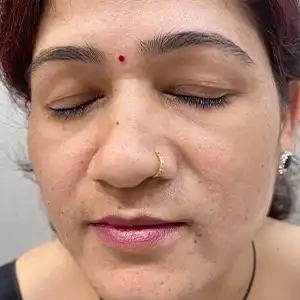Melasma
Treatment
We Strive to help
our patients achieve
flawless, even-toned skin
Melasma Treatment
We Strive to help
our patients achieve
flawless, even-toned skin

Introduction
Melasma is a common skin condition characterized by brown or grayish-brown patches on the face, often appearing on the cheeks, forehead, upper lip, and chin. It can be a frustrating condition that affects your skin’s appearance, but at Urban Skin and Hair Clinic, we offer advanced Melasma Treatments to help reduce pigmentation and restore your skin’s natural radiance. Our expert dermatologists provide personalized solutions to address the underlying causes and offer long-lasting results.
What is Melasma?
Melasma is a form of hyperpigmentation that causes dark, discolored patches to appear on the skin, typically on sun-exposed areas like the face. It occurs when the skin produces too much melanin due to various factors, including hormonal changes, sun exposure, and genetics. While melasma is not harmful, it can be a cosmetic concern, especially for those who experience it in prominent areas of the face.
Causes of Melasma
Melasma is caused by an overproduction of melanin, the pigment responsible for the color of the skin. Several factors contribute to this overproduction, including:
- Hormonal Changes: Pregnancy, birth control pills, and hormone replacement therapy (HRT) can trigger melasma, often referred to as the “mask of pregnancy.”
- Sun Exposure: UV radiation from the sun stimulates melanin production, exacerbating melasma symptoms.
- Genetics: A family history of melasma increases the likelihood of developing the condition.
- Skin Type: Individuals with darker skin are more prone to developing melasma.
- Pregnancy: Hormonal changes during pregnancy can cause melasma to appear or worsen.
- Certain Medications: Some medications, such as oral contraceptives, can trigger melasma in susceptible individuals.
- Cosmetic Products: Harsh skincare products that irritate the skin may contribute to the development of melasma.

Treatment Benefits
✅ Reduces Pigmentation: Effectively lightens the dark patches caused by melasma, leading to a more even skin tone.
✅ Improves Skin Texture: Helps to smooth out the skin, reducing roughness and improving overall texture.
✅ Restores Radiance: Brings back a healthy, glowing complexion by targeting stubborn pigmentation.
✅ Safe and Non-Invasive: Our treatments are gentle, with minimal downtime, making them suitable for all skin types.
✅ Prevents Future Pigmentation: With ongoing treatment and sun protection, melasma can be managed and prevented from recurring.
Before-After Results
Clients who undergo melasma treatment typically see significant improvements in the appearance of their skin. After a few sessions, dark patches become lighter, and overall skin tone becomes more even and radiant. Results are gradual, and consistency with treatments is key for long-lasting results. Before-and-after photos from our patients showcase the visible reduction in pigmentation and enhanced skin texture.

How to Prevent Melasma
- Use Sunscreen Daily: Apply a broad-spectrum sunscreen with SPF 30 or higher every day, even when indoors, as UV rays can penetrate through windows.
- Limit Sun Exposure: Avoid direct sun exposure, particularly during peak hours from 10 a.m. to 4 p.m.
- Wear Protective Clothing: Hats, sunglasses, and long sleeves can help shield your skin from the sun’s harmful rays.
- Avoid Hormonal Changes: If possible, try to manage hormonal changes that may trigger melasma, such as reducing the use of oral contraceptives.
- Choose Gentle Skincare Products: Use gentle, non-irritating products that won’t exacerbate melasma.
- Regular Dermatologist Check-ups: Regular consultations with your dermatologist can help keep melasma under control.
We offer the most advanced, dermatologist-approved treatments for melasma. Our treatments are customized based on the severity of melasma and your skin type:
- Laser Treatment: Fractional laser treatments help break down melanin deposits in the skin, reducing pigmentation and promoting skin regeneration.
- Chemical Peels: Medical-grade chemical peels exfoliate the skin, lighten dark spots, and stimulate new skin growth, leading to a more even complexion.
- Microneedling: This treatment uses fine needles to create micro-injuries in the skin, stimulating collagen production and enhancing the absorption of brightening serums for effective pigmentation reduction.
- HydraFacial: A non-invasive facial that cleanses, exfoliates, and hydrates the skin while reducing pigmentation and improving overall skin health.
- Topical Brightening Serums: We recommend medical-grade skincare products that lighten and brighten the skin by targeting melanin production.
- Sun Protection and Maintenance: We advise clients on how to protect their skin from further sun exposure and recommend the right sunscreen products to maintain results.
Each treatment is personalized to ensure the best possible outcome, and your dermatologist will guide you in selecting the most appropriate options for your specific case of melasma.
Treatment Options at Urban Skin and Hair Clinic

Introduction
Melasma is a common pigmentation disorder that affects many people, particularly women. It appears as irregular, brownish patches on the skin and is often caused by hormonal imbalances, sun exposure, genetics, and certain medications. While melasma is a benign skin condition, it can significantly impact a person’s self-esteem and confidence.
At Urban Clinic, we understand the emotional distress that melasma can cause, and we strive to help our patients achieve flawless, even-toned skin. Our team of experienced dermatologists specializes in treating various pigmentation concerns, including melasma, using revolutionary USFDA-approved methods with proven safety and efficacy.
One of the most effective treatments for melasma is a combination of topical creams and chemical peels. Our dermatologists will evaluate your skin type and the severity of your condition to recommend the most suitable treatment plan for you.
What Causes Melasma?
Melasma is a common skin condition that causes brown or grayish-brown patches on the skin. The exact cause of melasma is unknown, but there are several factors that can contribute to its development. Here are some of the primary causes of melasma:
Sun/UV Exposure: Exposure to UV radiation from the sun or electronic screens can trigger excess melanin production in the skin and worsen or cause melasma.
Hormonal Imbalances: Hormonal changes during pregnancy, menopause, or due to conditions like hypothyroidism can cause or worsen melasma. Estrogen and progesterone sensitivity is often linked to melasma.
Family History: Those with a family history of melasma have a higher risk of developing the condition.
Skin Colour: People with darker skin are more susceptible to melasma than those with lighter skin.
Chemical-based Skin Care Products: The use of skin-care products with fragrances and chemicals that can irritate the skin can trigger melasma.

Signs And Symptoms Of Melasma
- Freckle-like spots
- Flat patches of brown, blue or grey color
- Defined or diffused patches
- The patches usually occur symmetrically on the cheeks, forehead, nose, chin and jawline.
Melasma treatment
- Chemical peels are a cosmetic treatment that involves the application of natural extracts, such as glycolic acid and kojic acid, on discolored skin for controlled exfoliation of the top layers.
The purpose of this treatment is to inhibit melanin formation, which is responsible for the darkening of the skin. - Chemical peels are most effective in reducing epidermal melasma, a condition characterized by brown patches on the face.
- To attain visible results, multiple sessions of chemical peel treatment are typically required, with regular intervals of a few weeks between each session.
- The concentration of the natural extracts used in the chemical peel treatment is typically adjusted based on the severity of the skin discoloration and the patient’s skin type.
- During the treatment, the natural extracts are applied to the skin using a brush or sponge and left on for a certain amount of time before being rinsed off.
- After the treatment, it is common to experience redness, peeling, and some discomfort for a few days.
- It is important to follow the post-treatment instructions provided by the practitioner to minimize any side effects and achieve optimal results.
- Chemical peels are generally considered safe when performed by a qualified practitioner, but there are some risks involved, such as infection, scarring, and changes in skin color.
- Dermatologists at Urban use Q-switched Nd:YAG laser technology, which is USFDA-approved and considered safe and effective for treating deeper melasma that does not respond to topical medication and peel treatments.
- The laser beam targets excess melanin in the deeper layers of the skin, breaking it down without damaging or adversely affecting the surrounding skin.
- Multiple sessions may be required for optimal results, depending on the type and severity of your melasma. Your dermatologist will create a personalized treatment plan based on your specific needs.
- Regular maintenance may be necessary to keep the melasma under control and prevent recurrence.
- Laser treatment is generally well-tolerated, although some patients may experience mild discomfort or redness following the procedure.
- It’s important to follow your dermatologist’s post-treatment care instructions, which may include avoiding sun exposure and using sunscreen to protect your skin.
- Tranexamic acid is a medication that helps to prevent excessive bleeding by blocking the breakdown of blood clots in the body.
- Tranexamic acid can be administered by injection (intravenously or intramuscularly) to control bleeding in various medical conditions, such as heavy menstrual bleeding, surgery, trauma, and certain bleeding disorders.
- Injections of tranexamic acid are typically given under the supervision of a healthcare provider in a hospital or clinic setting.
- The dosage and duration of treatment with tranexamic acid injection may vary depending on the underlying condition being treated and the individual patient’s needs.
- Common side effects of tranexamic acid injection may include nausea, vomiting, diarrhea, headache, dizziness, and muscle or joint pain.
- Rare but serious side effects may include allergic reactions, blood clots, and seizures. It is important to seek medical attention if any of these side effects occur.
Melasma Treatment Cost in India
The cost of melasma laser treatment can vary widely depending on the severity of the condition, the type of laser used, and the number of sessions required. On average, the cost of melasma laser treatment in India ranges from Rs 5,000 to 15,000 per session. The cost may be higher or lower depending on the location of the clinic and the experience of the doctor.
The type of laser used for melasma treatment can also affect the cost. For example, fractional laser treatments are generally more expensive than traditional laser treatments.
It is important to note that multiple sessions may be required to achieve optimal results, so the total cost of treatment can add up.
Factors such as skin type, age, and overall health can also influence the cost and effectiveness of melasma laser treatment. You can come at our Urban Clinic where you will get full information about Melasma treatment.
Prior to undergoing melasma laser treatment, it is important to consult with a qualified dermatologist to discuss the potential risks, benefits, and cost of the procedure.
How To Prevent Melasma?
- Avoid excessive sun exposure during peak sunlight hours.
- Use protective gear like scarves, sunglasses, and umbrellas when going out in the sun.
- Regularly use sunscreen with SPF 30 or above as recommended by your dermatologist. Reapply every three hours.
- Maintain a nutrient-rich diet with vitamin D and establish proper skin-care habits to keep the skin healthy and protected from various skin disorders, including melasma.
- Consult a doctor before using hormonal pills or contraceptives, especially if you have a positive family history of melasma.

Consult a Specialist Today
Dr. Kiran Chotaliya, M.D., Dermatology & Hair Transplant Surgeon, specializes in treating pigmentation disorders, including melasma. With extensive experience in managing complex skin conditions, Dr. Chotaliya offers effective treatments that deliver long-term results. Her approach combines advanced technology with personalized care to restore your skin’s natural radiance.
Melasma Treatment FAQ
Melasma can be managed with treatment, but it may not be completely curable. However, the right treatment plan can significantly reduce its appearance and prevent recurrence with proper sun protection.
Most patients see improvement after 4-6 sessions, but the number of treatments depends on the severity of the melasma and the response to the treatments.
Yes, our treatments are designed to be safe for all skin types. Dr. Chotaliya will tailor the treatment plan based on your skin’s needs and sensitivities.
If melasma is triggered by hormonal changes or sun exposure, it may recur. However, with proper sun protection and follow-up treatments, the risk of recurrence can be minimized.
Most of our treatments are non-invasive and relatively painless. Some patients may experience mild discomfort during certain procedures, but it is generally well-tolerated.
Why Urban Skin and Hair Clinic

TEAM OF CERTIFIED DERMATOLOGISTS

US-FDA APPROVED EQUIPMENTS

HIGHLY STANDARDISED PROTOCOLS

1 LAKH + HAPPY CLIENTS
Melasma Treatment Results Before & After










